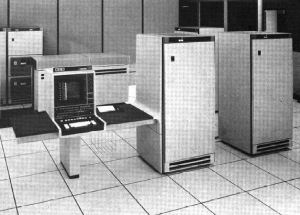|

The new NCR Century 300 system is the third and largest computer of the Century Series of computers. It is designed to provide the large-scale user with increased processing capabilities  and meets the multi-programming needs of the large-scale user at a lower price than any comparable system. and meets the multi-programming needs of the large-scale user at a lower price than any comparable system.
The NCR Century 300 is compatible with and retains the best elements of the two smaller NCR Century systems, the 100 and the 200, and it incorporates several unique Features:
They are an advanced processor for faster and more efficient processing. A memory capable of accessing four memory modules during a single cycle. A CRT (cathode Ray Tube) sub-system to enhance operator-sys(c iii communication.
In addition, the NCR Century 300 includes two new peripheral units that will offer more latitude in the design of a system configuration — a disc drum that permits faster access time and a controller for increased clew rapacity.The system offers the complete set of high-level COBOL elements and full FORTRAN, as well as NCR’s own programming language, NEAT/3.
An advanced multi-programming operating system is also being developed for the NCR Century 300. Some features included are job accounting, automatic job scheduling, common systems disc and program library, file and unit sharing, and system aided recovery.
The release of the NCR Century 300 is further evidence of the commitment made to the data processing community in March 1968 — when the NCR Century Series has been introduced.
The new system represents a further expansion of the market and the opportunity for current and potential customers to upgrade their equipment and obtain the best price/performance ratio now available for multi—programming and online, real-time applications.
The NCR Century 300 was the top of the line of the DTL logic implementation that used the 4x4 cards into the 440 slot backpanels (5 rows of 88 slots). It had three separate computers in one 615-300 to promote more parallel hardware operations. The units were called the “I” (Instruction fetch and setup), the “E” (Execution) and “I/O”. Each unit had an independent path into the memory. The memory was not in the same frame as the computer, but in a separate frame. The memories were the 618-920, 618-930 and 618-935. Each memory had 4 memory modules that any of the three 615-300 processor sections could access simultaneously. The memories were 4-way interleaved, meaning all of 4 of them within a cabinet worked asynchronously to each other.
|

